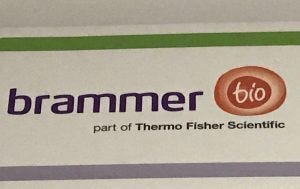
Thermo Fisher claims to be the “leading outsource provider of viral vector manufacturing,” nine months after entering the space through the acquisition of Brammer.
In March 2019, Thermo Fisher expanded its presence in the CDMO space by announcing plans to buy viral vector manufacturer Brammer Bio. Weeks later, the $1.7 billion deal closed, propelling Thermo Fisher into the gene therapy manufacturing space.
Nine months on and Thermo Fisher CEO Marc Casper said the business has “got off to a good start,” and claimed his firm to be “the leading outsource provider of viral vector manufacturing and development for gene therapies,” at the recent JP Morgan Healthcare Conference.

He also highlighted the projected growth rate within the Brammer business, stating that it is expected to grow by roughly 25% year-on-year “for the foreseeable future.”
Demand for viral vector manufacturing services is spiraling as increased numbers of gene therapies enter the clinic. According to a recent Bioprocess International report an increasing number of candidates needing 100-fold or more clinical vector for diseases requiring systemic administration –such as hemophilia and muscular dystrophies – has created a bottleneck in the industry. It also suggests that viral vector demand will exceed CDMO manufacturing capacity by Q1 2020.
In such an environment, it is unlikely Thermo Fisher/Brammer will be operating with excess capacity but to ensure such continued high levels of growth going forward, Casper pointed to the heavy investment the firm has made to expand its capacity and services.
“In December, I was part of the opening of our third facility, the one in Lexington, Massachusetts,” he told investors. The plant was one of three ventures that formed part of a $200 million three-year investment program begun by Brammer Bio in 2018.
But a further $125 million was allocated for further expansion by Thermo Fisher weeks after acquiring Brammer. “We’ll be breaking ground on our fourth facility in the very near future,” Casper confirmed.
“We feel very good about sort of what the pipeline is and the expansion of that business, and the first four facilities that we have should allow us to be able to achieve our goals for the next, I’d say, four or five years.”
About the Author
You May Also Like

schedl_b_and_w.jpg?width=100&auto=webp&quality=80&disable=upscale)
schedl_b_and_w.jpg?width=400&auto=webp&quality=80&disable=upscale)





